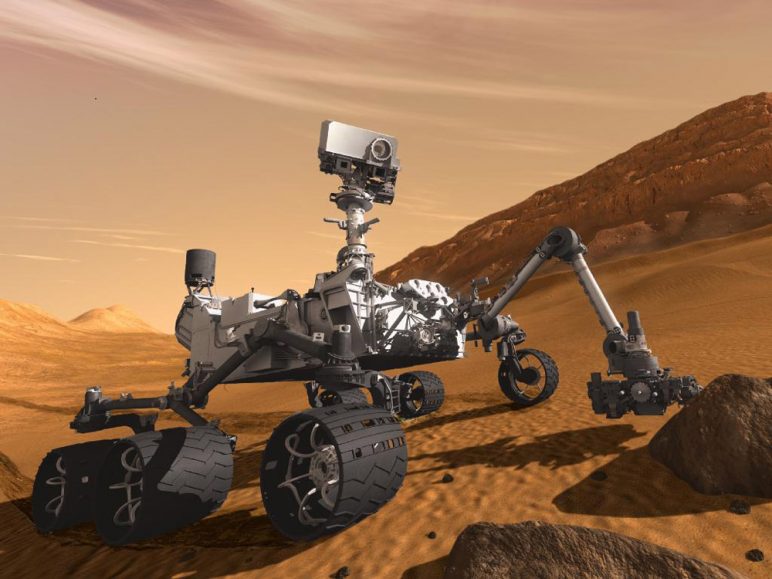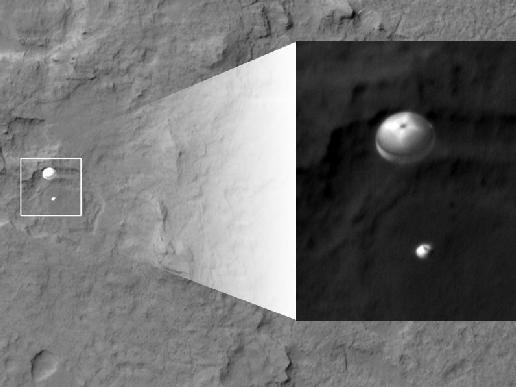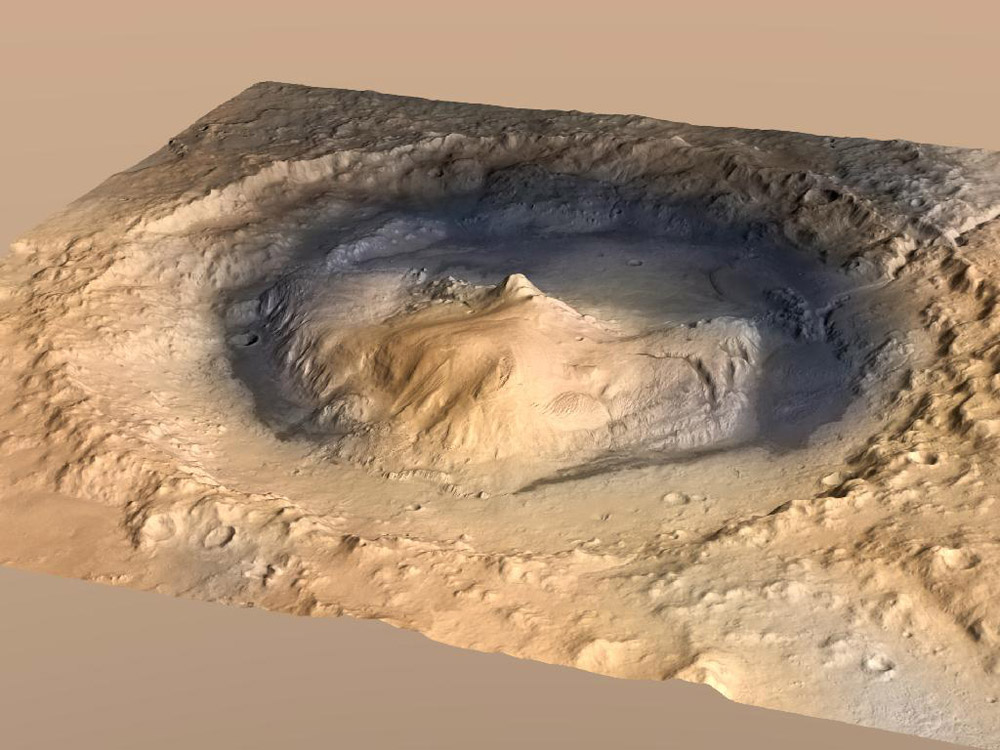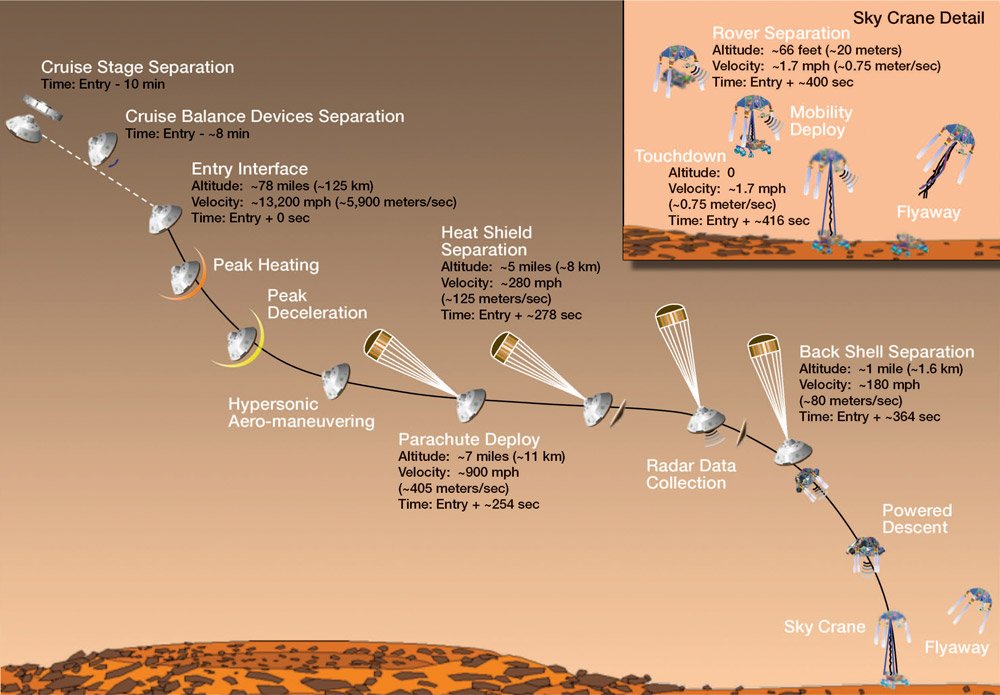Curiosity lands on Mars!
NASA successfully delivered a $2.5 billion robotic vehicle to Mars, one that will explore for signs that the planet might once have hosted life

Artist’s drawing of Curiosity on the Martian surface.
NASA
By Janet Raloff
On August 5, after a journey lasting more than 8 months, a carlike rover carefully settled down onto the surface of Mars. The vehicle is basically a science lab. Its mission: to search for evidence that the Red Planet might once have hosted life — even if the organisms were only one-celled microbes.
The first stage of this mission — the landing — is “an amazing achievement,” observes Charles Bolden. He runs the National Aeronautics and Space Administration, or NASA, which built and delivered the vehicle to Mars.
NASA named the robotic cruiser Curiosity. The six-wheeled all-terrain vehicle weighs 900 kilograms (about 1 U.S. ton). Roughly 2.8 meters (9 feet) long, it carries 10 research instruments. Seventeen separate cameras (including one on the rover’s belly, to scan below it) will survey the landscape and record experiments.
The rover’s primary goal “is to explore habitable environments,” says project scientist John Grotzinger of the Jet Propulsion Laboratory (JPL) in Pasadena, Calif. By habitable, he means an environment that can support life. His team interprets that to mean there must be water, carbon — a basic building block of life on Earth — and food to fuel an organism’s activities, he told Science News.

Curiosity is not the first rover NASA has sent to Mars, but it is the biggest and has the most research instruments. Think of it as a rolling laboratory that can travel 200 meters (656 feet) per day, up and over obstacles 65 centimeters (25 inches) high.
Several years ago, NASA scientists began considering the best place for Curiosity to conduct its experiments. Last year, the researchers chose Gale Crater. So that’s where the rover landed.
A towering peak — Mount Sharp — rises from the center of this basin 150 kilometers (93 miles) wide. Curiosity will spend two years motoring around and exploring the crater floor. The rover will be powered by energy given off by the decay of plutonium, a radioactive element.
But probing the mountain will be the vehicle’s primary focus. At roughly 5 kilometers (16,400 feet), Sharp rises higher above the landscape than does any mountain in the continental United States. It’s built from layer upon layer of mineral-rich materials. Some clays in it would seem to have required water to form. So as Curiosity moves by, it will shoot out a laser beam at the mountain and then direct onboard chemical samplers to “taste” the vaporized rock. Another onboard device can drill into rock, pulverizing it into a fine powder for the rover’s chemical samplers to taste.

Educators and Parents, Sign Up for The Cheat Sheet
Weekly updates to help you use Science News Explores in the learning environment
Thank you for signing up!
There was a problem signing you up.
Searching for life
Those samplers will decipher the rocks’ chemical makeup. The recipes might establish whether any of these materials could have supported life.
Shortly before the rover touched down, Science News reporter Nadia Drake spoke with JPL director Charles Elachi. He explained that scientists are “pretty convinced that Mars did have an ocean a few billion years ago.” An ancient sea would indicate that the temperature on the Red Planet should have been similar to Earth’s. And that, he says, almost immediately raises the question: “Could life have evolved on Mars?” And if it could, he asks: “Did life evolve? How far did it evolve? And where is it now?”
There’s no reason to suspect Earth is the only place to host life, Elachi told Drake. “I’m pretty sure life is there across the universe,” he said. “But as a scientist, you have to prove it.”
He cautions that Curiosity won’t actually be searching for life (although if it found a good candidate, its cameras would surely try to snap glamour shots to thrill Earth-bound scientists). Instead, the rover aims to just survey and sample rocks, soil and dust. Cameras — which serve as Curiosity’s eyes — will share what it sees with researchers back on Earth.
Getting there wasn’t easy
The rover’s landing was picture perfect. But it took a huge amount of planning and testing to find the appropriate parking place and deliver the $2.5 billion vehicle to it.
A spacecraft had to ferry the Curiosity rover over a distance of more than 560 million kilometers (350 million miles). Along the way, it had plenty of chances to get lost. So engineers placed cameras on the outside of the spacecraft to serve as eyes scanning for signposts. Much as pioneers and cattle drivers used mountains, rivers and other natural land formations to navigate the Old West, this spacecraft’s cameras relied on star formations to remain oriented.

The traveling spacecraft spun throughout its route. Any wobble in that spin would have made it hard for those eyes to find their stellar guides. So engineers applied weights to the outside of the spacecraft carrying the rover. It’s the same principle used when balancing a car’s tires. Mechanics spin the tire, look for any wobble, then add weights to compensate for where an uneven distribution of weight induces an unstable spin.
JPL researchers spun the Curiosity spacecraft on a rotating table, looking for where the uneven distribution of weight in the machinery and cargo would cause wobble. Then they applied two heavy weights to the outside of the spacecraft; each block of tungsten-based metal was about the size of a laptop computer. Those weights remained in place until just before the craft’s entry into the Martian atmosphere.
Planning for this landing required nearly a decade’s work, notes Adam Steltzner of JPL. He led the program that designed and coordinated the spacecraft’s entry, descent and landing phase.
Part of that planning determined when those weights had to be precisely jettisoned. “We toss them off,” he explains, because “that creates the imbalance that we use to develop lift.” Lift is an upward force acting on an object. (It’s what allows airplane wings to keep these vehicles in the air.) “It’s important that we get rid of those [weights], because without the lift,” Steltzner says, Curiosity would never have reached and gently set down on the carefully selected landing site.
Stunt double
NASA built Mars-bound Curiosity along with an identical twin. That second rover amounted to a stunt double. It underwent tests in the laboratory that might have risked Curiosity’s safety.
Curiosity was the first Mars rover that would parachute down through the atmosphere, landing only on its wheels. Savannah McCoy, an engineer at JPL, helped test the stunt double to ensure that Curiosity could complete the maneuver. If the vehicle landed too hard, it could destroy the wheels — maybe even the chassis, or frame. That would not be a good start for a vehicle that might be asked to travel 100,000 kilometers (62,000 miles) over the next several years.
The spacecraft initially zoomed toward the Red Planet at about 12,875 kilometers per hour (or 8,000 miles per hour), according to JPL’s Tomas Martin-Mur. He led the team responsible for navigating Curiosity. As the spacecraft got closer to Mars, the planet’s gravity tugged on the craft, accelerating its speed to about 21,000 kilometers per hour.
But as soon as it reached the thin Martian atmosphere, the spacecraft had to brake quickly, precisely — and carefully. The atmosphere helped, by offering some resistance, known as “drag.” The outside of the spacecraft heated intensely as it zoomed through this atmosphere.

Several minutes later the craft had cooled somewhat. Here, at about 11 kilometers (some 6.8 miles) above the Martian surface, a mammoth parachute sprung open to further slow Curiosity’s descent. At an altitude of about 1 mile, the parachute was cut free and the spacecraft ejected the rover.
But the valuable vehicle didn’t crash. The rover dangled by ropelike tethers below a final stage of the spacecraft, known as a sky crane. Powerful engines, called thrusters, on the landing craft turned on at precisely timed intervals. These further braked Curiosity’s fall to a gentle pace. Immediately after landing, the sky crane flew away, to set down well clear of the rover.
A half-day before touchdown, Steltzner noted with relief that Mars’ atmosphere had decided to cooperate with Curiosity’s arrival by delivering “perfect” weather for landing. The spacecraft was arriving in a transitional season on the planet, a time “between the cold and clear season on Mars and the warm and dusty season,” he said. During this in-between period, many storms develop.
Such storms had begun developing in the weeks before Curiosity’s descent, Steltzner says. That could have made maneuvering to the landing site difficult. One storm raged just east of the rover landing site but didn’t get in Curiosity’s way. And luckily, once the rover touches down onto the Martian surface, “dust doesn’t really matter,” the researcher explains.
President Obama has asked NASA to plan for sending humans to Mars in the mid-2030s. This week’s successful landing “marks a significant step toward achieving this goal,” NASA director Bolden says.
NOTE: This story has been corrected for a distance measurement error on the parachute deployment altitude in the original version.







